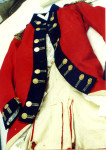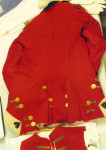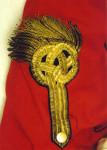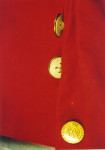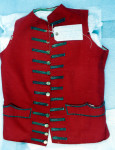Singleton’s Light Infantry Company
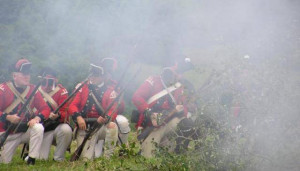 Brief History of the 2nd Battalion, KRR NY
Brief History of the 2nd Battalion, KRR NY
During its eight year lifespan, 1776-84, the Royal Yorkers wore two distinctly different uniforms (please see the “Articles” section of this website for more details
.)
For the first three years, the regiment drew light infantry pattern clothing from QM Stores that had originally been sent out for the Quebec Militia. The garments came in pre-cut kits for making up green jackets with buff turnbacks, plain pewter buttons and red facings and waistcoats and breeches in buff melton, although the latter was soon replaced with more practical overalls and trousers. A mild debate persists about whether Sir John purchased blue cloth to replace the red for facings.
After 1779, the uniforms came directly to the regiment from Britain and were again cut to light infantry designs. The men wore red jackets with blue facings, white turnbacks and regimentally ciphered buttons. The line infantry received white melton waistcoats. To judge from James Peachey’s detailed painting of two 1st battalion companies’ settlement at Royal Township No.2 in 1784, a variety of trouser types were worn in the second clothing period.
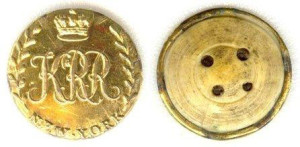 Whether Sir John Johnson had any choice in the new uniform’s facing colour and other design features is debatable; however, there’s no doubt that the buttons were specifically designed for the regiment. We have information that Johnson wanted the men’s buttonholes laced with a blue worm pattern, but there is no information that his request was granted. Officers buttonholes were outlined in ¼” gold lace and their buttons were gilt and regimentally ciphered, in this case with script letters, while the other ranks’ pewter version had block letters.
Whether Sir John Johnson had any choice in the new uniform’s facing colour and other design features is debatable; however, there’s no doubt that the buttons were specifically designed for the regiment. We have information that Johnson wanted the men’s buttonholes laced with a blue worm pattern, but there is no information that his request was granted. Officers buttonholes were outlined in ¼” gold lace and their buttons were gilt and regimentally ciphered, in this case with script letters, while the other ranks’ pewter version had block letters.
An extant officer’s scarlet jacket and waistcoat are on display in the Canadian War Museum in Ottawa. This is the only surviving KRR NY uniform out of the thousands that were worn during the war. The two garments belonged to Lieutenant Jeremiah French of George Singleton’s Light Infantry Company of the 2nd battalion.
Singleton was an Irish-born, Mohawk-speaking trader from Montreal. He joined the regiment shortly after its founding in June 1776 and was a lieutenant in the 1st battalion’s Light Infantry Company. During the St. Leger campaign, he was wounded at the Oriskany battle. Having been taken back to the regiment’s camp outside Fort Stanwix, he was captured in a bold sortie by the fort’s garrison. In May 1780, he was exchanged for a rebel officer and a year later was promoted to captain of the 2nd battalion’s Light Company.
Jeremiah French had been a captain in the Queen’s Loyal Rangers during the Burgoyne expedition and saw action in the catastrophic defeat at Bennington on August 16, 1777. Despite their excellent records, he and his brother fell-out with their lieutenant-colonel, who charged them with a great number of offences. When a court martial completely exonerated the brothers, Jeremiah decided he could no longer serve in the QLR and accepted a more junior rank in the Yorkers’ 2nd battalion. Sir John reported him to be “a very loyal Subject…and…a brave man.”
During 1781 and ’82, 2nd battalion troops were sent on a great number of scouts and raids into the Mohawk Valley. In October 1781, the battalion’s commander, Major John Ross, led an expedition through the breadth of the Mohawk Valley to just outside Schenectady without alerting the defenders and destroyed the harvests and farms of Warrensborough. Rebel forces caught up with the expedition just as it withdrew into the woods north of Johnson Hall. A short, sharp action was fought and the rebel force was defeated; however, their flanking force surprised Ross’s troops and the fighting continued almost until dark. The expedition was able to get away, but it was overtaken a few days later and the rearguard suffered some losses.
Early in 1782, Singleton’s was involved in the secret rebuilding of Fort Ontario at Oswego, which gave the rebel administration much concern. That July, Singleton led his Lights on the final raid of the war into the Mohawk Valley. This expedition was commanded by the Mohawk war captain, Joseph Brant, and was said to be the largest commitment of Six Nations’ and affiliated Indians during the war. Brant and Singleton had both seen their first action of the war at Oriskany, so it was fitting that they embarked on this endeavour together. Despite the raiders’ overwhelming numbers, they accomplished little, as the central valley was virtually devastated and the rebels hunkered down in fortifications and sensibly refused to be lured out.
In 1783, Singleton’s Company helped to rebuild Fort Frontenac at Cataraqui and, when disbandment finally came in June 1784, the men settled with the majority of the 2nd battalion at Cataraqui Township No.3 near the Bay of Quinte.
Our Recreated Company
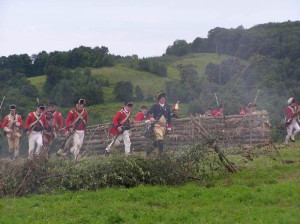 The Uniform – It’s such a pleasure to wear the second clothing period’s red uniform. At a glance, Americans know you’re the ‘bad guys’ – which is the exact point of the exercise – and Canadians think you’re heroes. It’s wonderful!
The Uniform – It’s such a pleasure to wear the second clothing period’s red uniform. At a glance, Americans know you’re the ‘bad guys’ – which is the exact point of the exercise – and Canadians think you’re heroes. It’s wonderful!
In comparison, wearing the confusing green uniforms of the Royal Yorkers’ earlier existence needs much explanation to historically uninformed audiences. “Who are you guys? Germans? Irish?” And, you have to fend off the thought that just maybe you’re rebels – after all, Ethan Allen’s Green Mountain Boys wore green and so did Light Horse Harry Lee’s Legion in the south. Once you’ve explained the situation to a few hundred people, you could get a job explaining the national debt.
But, up here in the frozen north, redcoats are known as “good guys” and that’s very refreshing, yet nothing really changes when you start to explain that you’re representing a New York regiment. People’s eyes still glaze over, just like when you’re wearing green. Plus çe change, plus c’est la même chose.
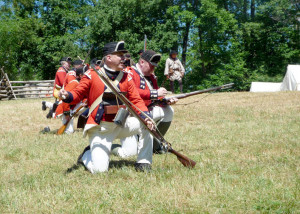 Choice of Company – After recreating a line company for thirteen years, we converted to Singleton’s Light Infantry in 1998. First, we added wings to our jackets’ shoulders. We had determined that red waistcoats were worn by our Lights from two pieces of evidence. 1. Lieutenant French’s extant example and 2. James Peachey’s painting of the 1st battalion Light Company settlement at Royal Township No.2. So, new red waistcoats became a second differentiating item of kit. The other clothing and the arms and accoutrements are the same as used in the 1st battalion.
Choice of Company – After recreating a line company for thirteen years, we converted to Singleton’s Light Infantry in 1998. First, we added wings to our jackets’ shoulders. We had determined that red waistcoats were worn by our Lights from two pieces of evidence. 1. Lieutenant French’s extant example and 2. James Peachey’s painting of the 1st battalion Light Company settlement at Royal Township No.2. So, new red waistcoats became a second differentiating item of kit. The other clothing and the arms and accoutrements are the same as used in the 1st battalion.
Our captain, Jeff Paine, and Eric Lorenzen got permission to minutely examine the Jeremiah French clothing at the War Museum and took copious notes and a great many photographs of the construction details. After assembling the necessary materials, Eric tailored an exact copy of the French jacket and waistcoat, which Captain Paine wears on ceremonial occasions.
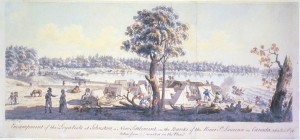 Headgear was another consideration. Back in 1985, we examined Peachey’s painting of the two companies settling at New Johnstown and saw they wore slouch hats. We concluded that the men had simply flopped the brims of their cocked hats and chose to wear slouches. We continued with slouches as Singleton’s for several years, although they had always been rather unserviceable in the bush.
Headgear was another consideration. Back in 1985, we examined Peachey’s painting of the two companies settling at New Johnstown and saw they wore slouch hats. We concluded that the men had simply flopped the brims of their cocked hats and chose to wear slouches. We continued with slouches as Singleton’s for several years, although they had always been rather unserviceable in the bush.
When the 1st battalion companies converted to cap-hats, we reexamined Peachey’s painting and noted that, despite the artist’s amazing attention to the smallest details, there was no indication that any of the slouch hats had ever been cocked. The brims were dead flat and the hats seemed to have been issued from new stock, perhaps as a bonus to the veterans. Further research indicated that the British 29th Regiment, which had served alongside the Royal Yorkers since 1776, continued to wear cap-hats in 1782 and Singleton’s converted to cap-hats.
Recruitment – All 2nd battalion members are recruited from within the 1st battalion. Three filters are applied – First, a recruit must have two years’ experience and be proficient in line and light infantry drills. Second, the recruit must have his 1st battalion debt in good order. Third, candidates must be approved by Singleton’s existing membership.
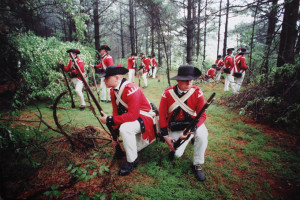 The advantages of this system are obvious. New members are well trained and easily absorb the adjustments necessary for 2nd battalion operations; they have little trouble meeting the additional expense of a new uniform and they readily fit into the fabric of the company.
The advantages of this system are obvious. New members are well trained and easily absorb the adjustments necessary for 2nd battalion operations; they have little trouble meeting the additional expense of a new uniform and they readily fit into the fabric of the company.
Singleton’s employs several manoeuvres from William Howe’s 1774 Instructions for Light Infantry and maintains a high degree of tactical proficiency, building on the superior light experience of the overall regiment. The company is capable of adapting quickly to changing situations and the members experience the thrill of efficiently executing drills and tactics under pressure.
As all members have extensive experience and many are serving or former officers and NCOs in the 1st battalion, the company’s leadership is under pressure to “get things right.”
